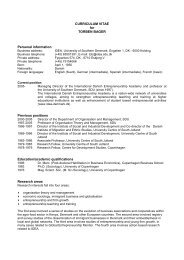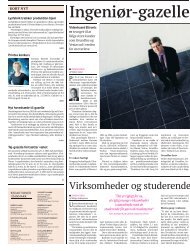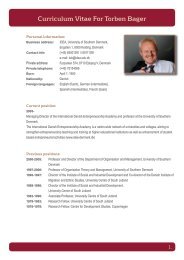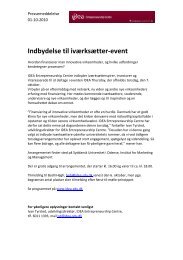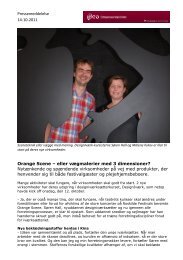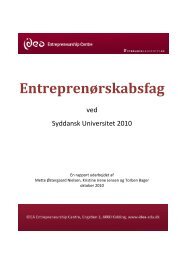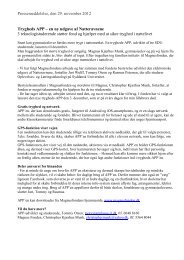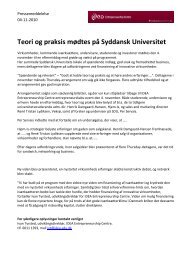Education, Training and Networking for Entrepreneurship in ...
Education, Training and Networking for Entrepreneurship in ...
Education, Training and Networking for Entrepreneurship in ...
You also want an ePaper? Increase the reach of your titles
YUMPU automatically turns print PDFs into web optimized ePapers that Google loves.
future. To measure such expectations we ask<br />
the starters,<br />
How many people will be work<strong>in</strong>g <strong>for</strong> this<br />
bus<strong>in</strong>ess, not count<strong>in</strong>g the owners but <strong>in</strong>clud<strong>in</strong>g<br />
all exclusive subcontractors, when it is five<br />
years old?<br />
An exist<strong>in</strong>g firm may already employ some people,<br />
<strong>and</strong> may expect positive or negative growth,<br />
that is, expansion, stability or contraction. The<br />
owner-managers are asked similarly,<br />
Five years from now how many people, not<br />
count<strong>in</strong>g the owners but <strong>in</strong>clud<strong>in</strong>g all exclusive<br />
subcontractors, will be work<strong>in</strong>g <strong>for</strong> this<br />
bus<strong>in</strong>ess?<br />
To measure the change, we also ask the ownermanager<br />
about the current size,<br />
Right now how many people, not count<strong>in</strong>g the<br />
owners but <strong>in</strong>clud<strong>in</strong>g exclusive subcontractors,<br />
are work<strong>in</strong>g <strong>for</strong> this bus<strong>in</strong>ess?<br />
The expected change <strong>in</strong> number of people work<strong>in</strong>g<br />
<strong>for</strong> the firm is then,<br />
Number expected <strong>in</strong> five years – Number<br />
now,<br />
where the ’Number now’ <strong>in</strong> a startup is 0 (if a<br />
respondent reports to be start<strong>in</strong>g but also reports<br />
to have a staff, then I here classify the respondent<br />
as an owner-manager <strong>in</strong> an exist<strong>in</strong>g<br />
bus<strong>in</strong>ess).<br />
Expected change is often expressed alternatively<br />
as a ratio, the future relative to the present,<br />
(1 + Number expected <strong>in</strong> five years) / (1 +<br />
Number now)<br />
where 1 is added to represent the starter or<br />
owner.<br />
This expected change may also be expressed<br />
on a logarithmic scale as<br />
Logarithm [ (1 + Number expected <strong>in</strong> five<br />
years) / (1 + Number now) ],<br />
which may equally well be written as<br />
Logarithm [ 1 + Number expected <strong>in</strong> five years ]<br />
– Logarithm [ 1 + Number now ]<br />
which is the change <strong>in</strong> size, where size is measured<br />
on a logarithmic scale. This way of measur<strong>in</strong>g<br />
expected change is especially suitable<br />
here (this avoids outliers, the few respondents<br />
report<strong>in</strong>g a huge change <strong>in</strong> number of employees,<br />
who would distort an analysis of number of<br />
employees). This logarithmic measure of expectation<br />
will be used extensively <strong>in</strong> tests <strong>in</strong><br />
this chapter.<br />
Entrepreneurs differ considerably <strong>in</strong> their expectations,<br />
Table 12.1. Many entrepreneurs expect<br />
to exp<strong>and</strong> by add<strong>in</strong>g jobs, but many also<br />
expect no change <strong>in</strong> jobs.<br />
Expectations differ widely by phase. Most starters<br />
expect to exp<strong>and</strong>, whereas most ownermanagers<br />
expect to have no change, i.e. neither<br />
expansion nor contraction. Because starters<br />
<strong>and</strong> owner-amanagers differ so widely <strong>in</strong> their<br />
expectations, they will be analyzed separately<br />
<strong>in</strong> the follow<strong>in</strong>g.<br />
Table 12.1<br />
Expectations about growth<br />
Starters <strong>and</strong> owner-managers <strong>in</strong> Denmark 2003-08<br />
Starters<br />
Owner-managers<br />
Expansion expected 75 % 35 %<br />
No change expected 25 % 58 %<br />
Contraction expected - 7 %<br />
Sum 100 % 100 %<br />
Additional jobs expected, median of numbers 3 0<br />
Additional jobs expected, mean of numbers 12.1 3.5<br />
Additional jobs expected, mean of logarithmic measure 1.5 0.2<br />
N respondents 383 1.550<br />
75




